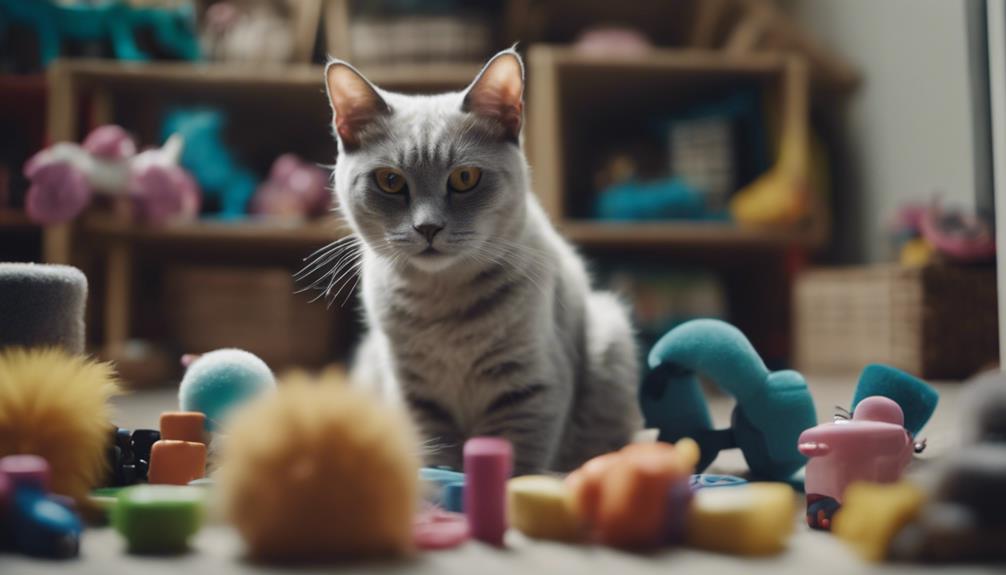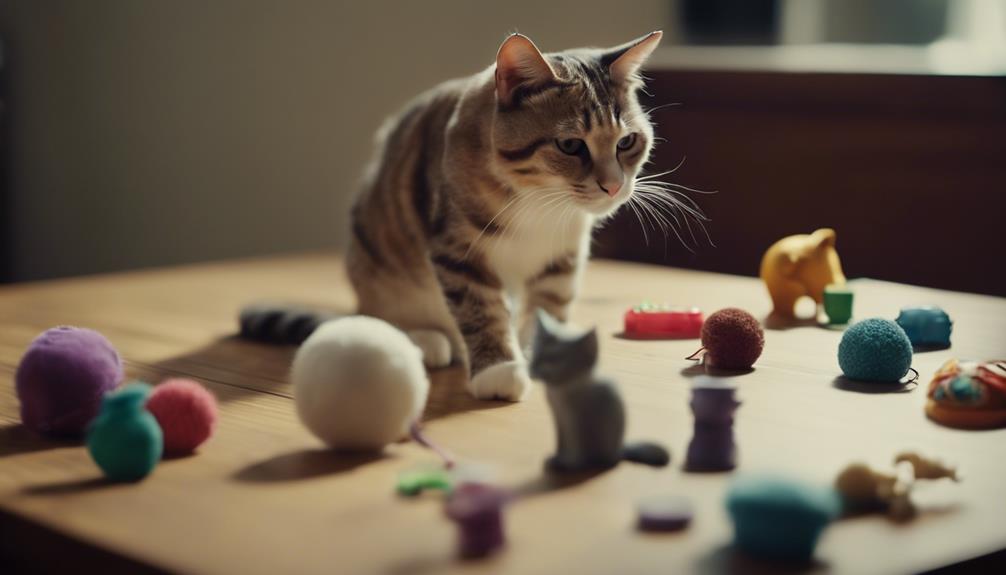What Are the Challenges of Socializing a Blind or Deaf Cat?

Challenges of Socializing a Blind or Deaf Cat:
Unique and complex hurdles in communication, trust-building, and addressing behavioral issues require patience and understanding of feline behavior.
Communication Barriers
Communicating with a blind or deaf cat can present unique challenges due to the absence of visual or auditory cues. Training techniques play a crucial role in overcoming these barriers. For a deaf cat, using hand signals instead of verbal commands can be effective. Consistency and positive reinforcement are key to helping them understand desired behaviors.
Bonding strategies are essential for building trust and understanding. Spending quality time with the cat, using touch and scent as sensory cues, can help create a strong connection. Communication methods like gentle strokes or tapping the floor to get their attention can facilitate interaction.
Understanding the cat's individual preferences and needs is vital in establishing effective communication. Patience, empathy, and a willingness to adapt to their unique way of perceiving the world are crucial. By employing appropriate training techniques and bonding strategies, caregivers can navigate the challenges of socializing a blind or deaf cat with compassion and understanding.
Sensory Limitations

Cats that are blind or deaf face unique challenges due to their sensory limitations. Training and communication methods need to be adapted to accommodate these limitations, ensuring that the cat can understand commands and cues effectively.
Providing enrichment activities that focus on other senses such as touch or smell can help these cats engage in play and feel stimulated.
Training and Communication
When socializing a blind or deaf cat, it is essential to establish clear, consistent training methods that cater to their sensory limitations. Using positive reinforcement and tactile cues can help them understand commands and behaviors effectively. Interactive games and scent training are valuable tools to engage them and build a strong bond. Here is a table to provide a visual aid for understanding how to communicate and train a blind or deaf cat effectively:
| Communication Method | Description |
|---|---|
| Positive Reinforcement | Rewarding desired behaviors with treats or affection. |
| Tactile Cues | Using touch to guide the cat's movements or indicate commands. |
| Interactive Games | Engaging activities that stimulate the cat's senses and promote interaction. |
| Scent Training | Introducing scents to help the cat recognize different areas or objects. |
Enrichment and Play
To engage a blind or deaf cat effectively in enrichment and play activities, consider incorporating sensory stimuli that cater to their unique needs and limitations. Providing appropriate enrichment and play opportunities is essential for the well-being of these special cats. Here are some tips to help you create an engaging environment for your blind or deaf feline friend:
- Use interactive toys: Choose toys that stimulate their senses of touch and smell.
- Rotate toys regularly: Keep playtime routines exciting by introducing new toys or scents.
- Create safe play spaces: Ensure the environment is free of obstacles to prevent accidents.
- Encourage mental stimulation: Engage their minds with puzzle toys or treat-dispensing games.
- Incorporate sensory engagement: Utilize toys that make sounds or have different textures to keep them entertained.
Navigating the surroundings and ensuring safety for a blind or deaf cat involves thoughtful consideration of their sensory limitations and unique needs. Indoor exploration should be encouraged, ensuring a safe environment free of obstacles. Outdoor hazards pose significant risks, necessitating careful supervision or restricting outdoor access entirely. Below is a table outlining key considerations:
| Indoor Exploration | Outdoor Hazards |
|---|---|
| Provide tactile cues like textured mats | Avoid toxic plants or chemicals |
| Use scent markers for orientation | Secure outdoor enclosures for safety |
| Consider auditory stimulation with toys | Monitor closely for potential dangers |
Trust Building

Building trust with a blind or deaf cat requires patience, consistency, and understanding of their unique needs and communication methods. To establish a strong bond with these special animals, consider the following tips:
- Respect Their Space: Allow the cat to approach you on their terms without forcing interactions.
- Use Scent: Cats rely heavily on scent to recognize individuals, so use familiar scents to help them feel comfortable.
- Positive Reinforcement: Reward good behavior with treats or gentle pets to create positive associations.
- Routine is Key: Stick to a predictable schedule for feeding, playtime, and affection to build trust through consistency.
- Non-Verbal Communication: Utilize touch, vibrations, or gentle motions to communicate with a deaf or blind cat effectively.
Environmental Adaptations

When adapting the environment for a blind or deaf cat, sensory enrichment options play a vital role in providing stimulation and comfort.
Communication tools specifically tailored for bonding can help bridge the gap in understanding between the cat and its human companions.
These adaptations are essential for creating a safe and welcoming space that enhances the quality of life for a blind or deaf feline friend.
Sensory Enrichment Options
To enhance the sensory experience for a blind or deaf cat, creating a stimulating environment through various adaptations can significantly improve their quality of life. Providing sensory enrichment options tailored to the cat's specific needs is crucial. Here are some suggestions to help enrich their environment:
- Interactive toys: Engage the cat's sense of touch and hearing.
- Puzzle feeders: Encourage mental stimulation and problem-solving.
- Scented toys: Utilize scents to compensate for the lack of vision or hearing.
- Tactile surfaces: Offer different textures for the cat to explore and navigate.
- Safe exploration areas: Create designated spaces where the cat can roam and investigate safely.
Communication Tools for Bonding
Effective communication tools tailored to the specific needs of blind or deaf cats can significantly enhance the bonding experience between feline companions and their human caregivers. Bonding activities play a crucial role in building trust and a strong relationship with these special cats.
Communication strategies for bonding include using tactile cues such as gentle strokes and pats to convey affection and reassurance. Additionally, incorporating interactive play sessions with toys that make noise or have interesting textures can help engage blind or deaf cats. Consistency in using verbal cues or hand signals for commands can also aid in establishing clear communication.
Socialization Techniques

Navigating the world as a blind or deaf cat can be challenging, but with the right socialization techniques, these fur babies can thrive and lead fulfilling lives. Here are some techniques to help socialize blind or deaf cats:
- Playful engagement: Encourage playtime using toys that make noise or have textures they can explore.
- Positive reinforcement: Reward good behavior with treats or affection to create positive associations.
- Scent recognition: Use scents to help your cat identify different areas or people in the house.
- Gentle touch: Get them accustomed to touch by petting them gently and speaking softly.
- Consistent routines: Establish consistent feeding times and play schedules to help them feel secure and comfortable.
Behavioral Challenges

Blind or deaf cats may experience behavioral challenges due to their sensory impairments, requiring specialized care and understanding from their owners. When addressing these challenges, training methods and socialization techniques play a crucial role. Positive reinforcement training can be especially effective in helping these cats adapt to their environment. By using rewards like treats or praise, owners can encourage desired behaviors and build trust with their feline companions.
Behavior modification is another key aspect to consider. Cats with sensory impairments may exhibit behaviors like fearfulness, aggression, or excessive vocalization. Through patience and consistency, these behaviors can be addressed and modified. Providing sensory stimulation is essential in keeping these cats engaged and mentally stimulated. Interactive toys, scratching posts, and puzzle feeders can help prevent boredom and promote healthy behaviors.
Health and Safety Concerns

Ensuring the health and safety of a blind or deaf cat requires vigilant observation and proactive measures by their caretaker. It's essential to address specific challenges that may arise to provide a secure environment for these special pets.
- Outdoor exploration: Create a safe outdoor space or use a leash to allow supervised exploration.
- Interactive toys: Engage the cat with toys that stimulate their other senses, promoting mental and physical well-being.
- Veterinary care: Regular check-ups are crucial to monitor the cat's overall health and address any specific needs promptly.
- Emergency preparedness: Have a plan in place for emergencies, including contact information for a vet familiar with the cat's condition.
- Home environment: Remove hazards, secure windows and balconies, and ensure the cat has easy access to food, water, and litter boxes in familiar locations.
Frequently Asked Questions
Can a Blind or Deaf Cat Still Enjoy Playing With Toys?
A blind or deaf cat can still enjoy playing with toys through sensory enrichment and interactive play. Providing a stimulating environment for tactile exploration will help them engage and have fun, enhancing their quality of life.
How Can I Ensure My Blind or Deaf Cat Feels Safe and Comfortable in My Home?
Ensuring a blind or deaf cat feels safe and comfortable involves providing sensory enrichment and using effective communication methods. Creating a secure environment, offering tactile experiences, and employing visual cues can help build trust and facilitate a sense of security for the feline.
Are There Specific Training Techniques for Teaching a Blind or Deaf Cat Commands or Cues?
When teaching a blind or deaf cat commands, positive reinforcement techniques like clicker training can be effective. Using touch, scent, and vibration as communication methods, bonding and relationship building become key components in establishing trust and understanding between cat and owner.
To help a blind or deaf cat navigate outdoor environments safely, provide indoor enrichment to stimulate their senses. Consider using protective gear like a harness with a leash for controlled exploration, ensuring their safety while allowing them to experience the world.
Are There Any Specific Health Risks or Concerns I Should Be Aware of for a Blind or Deaf Cat?
When caring for a blind or deaf cat, it's essential to consider mental stimulation and specialized veterinary care. These cats may face unique health risks, such as potential injuries due to their sensory impairments, requiring attentive monitoring and proactive intervention.











